Employer Perceptions on Workplace Health and Wellbeing in Kigali City
VerifiedAdded on 2023/06/07
|59
|14318
|230
Thesis and Dissertation
AI Summary
This thesis investigates employer perceptions on the promotion of workplace health and wellbeing in public and private institutions in Kigali, Rwanda. Using a qualitative cross-sectional design involving key informant interviews and focus groups, the study explores employer's perceptions and contributing factors. The research identifies main interventions, potential beliefs, and influencing factors related to workplace health and wellbeing. Findings reveal that employers generally believe in the importance of improved working conditions for productivity and worker welfare. The study concludes that initiatives and interventions should consider diverse workplace circumstances and highlights the importance of employer engagement in promoting a safe and healthy work environment.
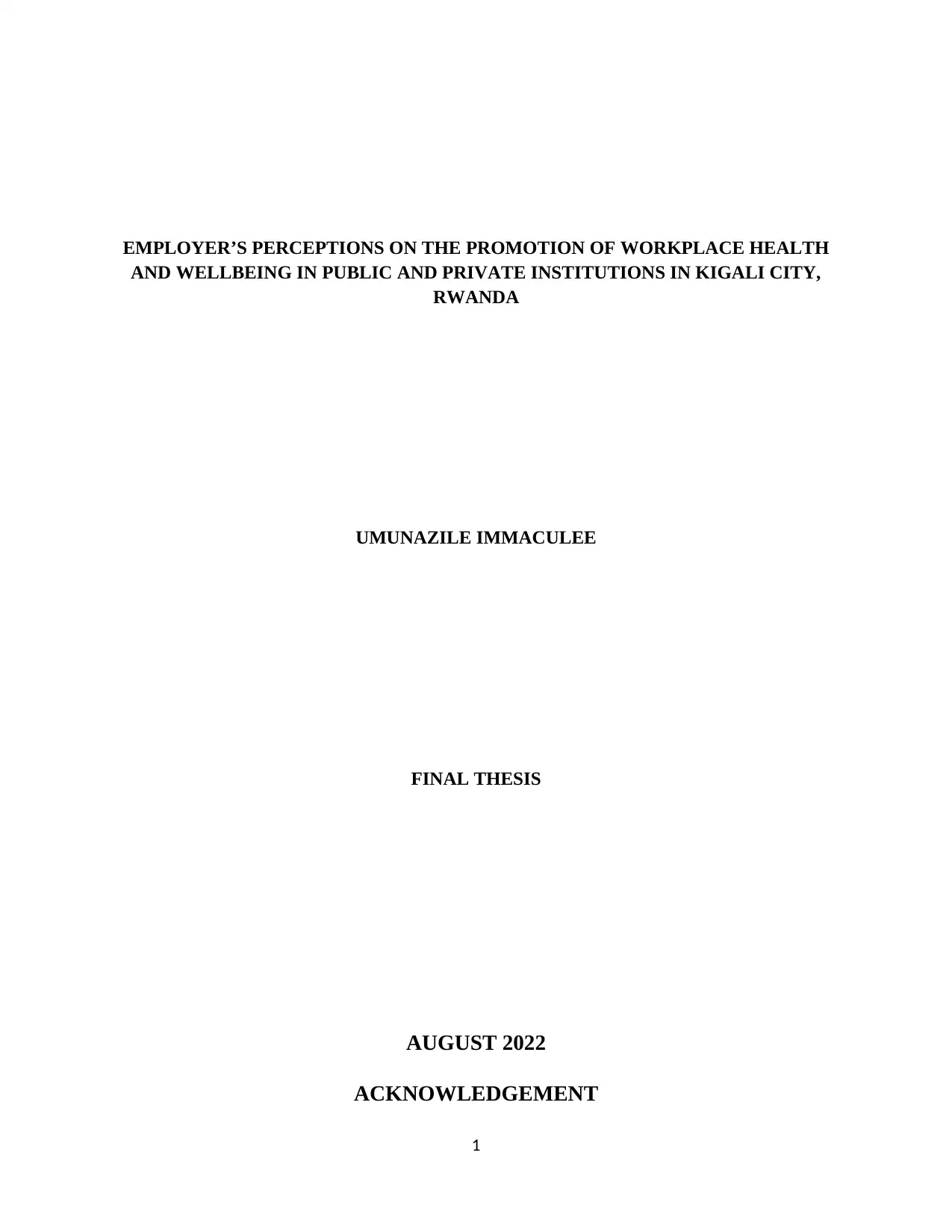
EMPLOYER’S PERCEPTIONS ON THE PROMOTION OF WORKPLACE HEALTH
AND WELLBEING IN PUBLIC AND PRIVATE INSTITUTIONS IN KIGALI CITY,
RWANDA
UMUNAZILE IMMACULEE
FINAL THESIS
AUGUST 2022
ACKNOWLEDGEMENT
1
AND WELLBEING IN PUBLIC AND PRIVATE INSTITUTIONS IN KIGALI CITY,
RWANDA
UMUNAZILE IMMACULEE
FINAL THESIS
AUGUST 2022
ACKNOWLEDGEMENT
1
Paraphrase This Document
Need a fresh take? Get an instant paraphrase of this document with our AI Paraphraser
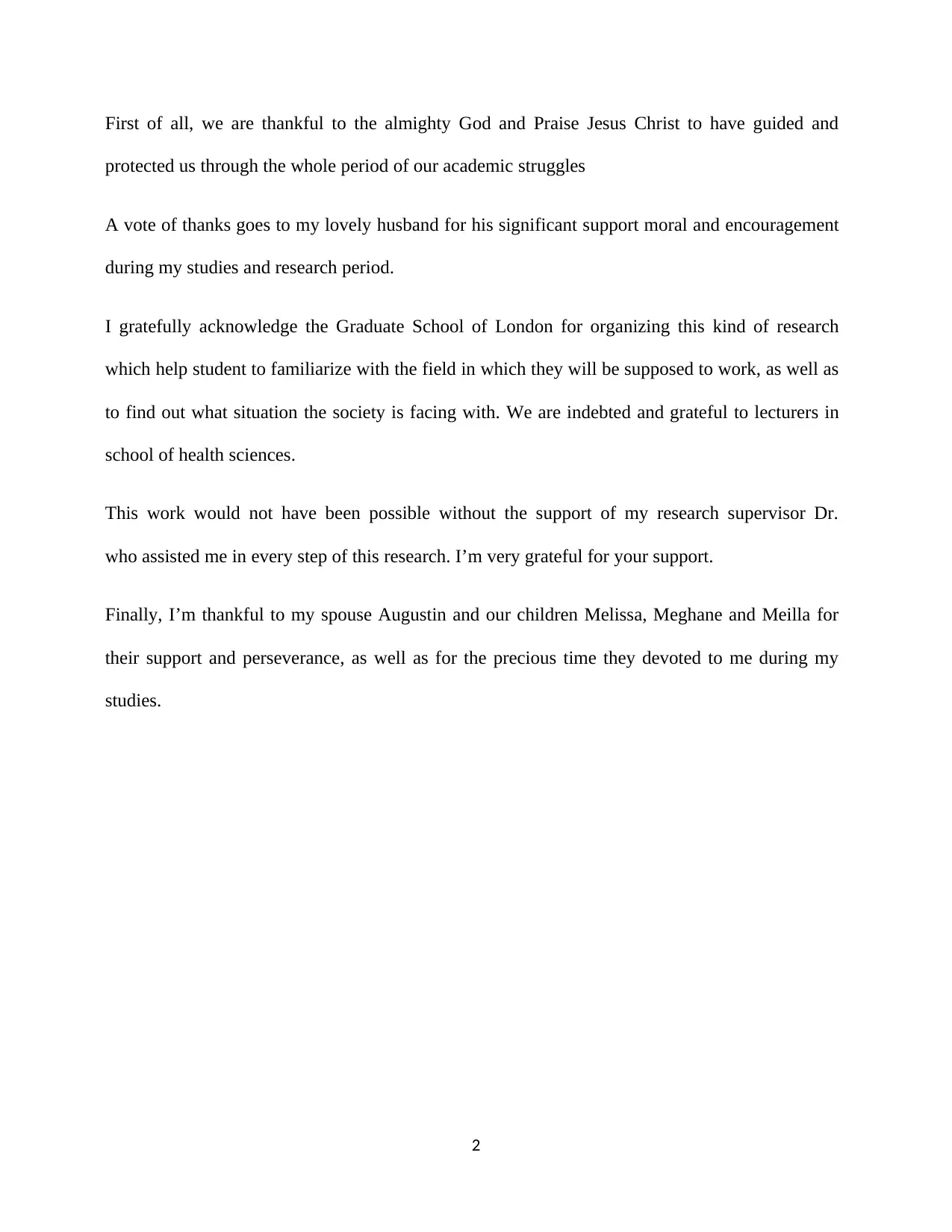
First of all, we are thankful to the almighty God and Praise Jesus Christ to have guided and
protected us through the whole period of our academic struggles
A vote of thanks goes to my lovely husband for his significant support moral and encouragement
during my studies and research period.
I gratefully acknowledge the Graduate School of London for organizing this kind of research
which help student to familiarize with the field in which they will be supposed to work, as well as
to find out what situation the society is facing with. We are indebted and grateful to lecturers in
school of health sciences.
This work would not have been possible without the support of my research supervisor Dr.
who assisted me in every step of this research. I’m very grateful for your support.
Finally, I’m thankful to my spouse Augustin and our children Melissa, Meghane and Meilla for
their support and perseverance, as well as for the precious time they devoted to me during my
studies.
2
protected us through the whole period of our academic struggles
A vote of thanks goes to my lovely husband for his significant support moral and encouragement
during my studies and research period.
I gratefully acknowledge the Graduate School of London for organizing this kind of research
which help student to familiarize with the field in which they will be supposed to work, as well as
to find out what situation the society is facing with. We are indebted and grateful to lecturers in
school of health sciences.
This work would not have been possible without the support of my research supervisor Dr.
who assisted me in every step of this research. I’m very grateful for your support.
Finally, I’m thankful to my spouse Augustin and our children Melissa, Meghane and Meilla for
their support and perseverance, as well as for the precious time they devoted to me during my
studies.
2

LIST OF TABLE
Table 4.1 Characteristics of the study participants………………………………………………27
3
Table 4.1 Characteristics of the study participants………………………………………………27
3
⊘ This is a preview!⊘
Do you want full access?
Subscribe today to unlock all pages.

Trusted by 1+ million students worldwide
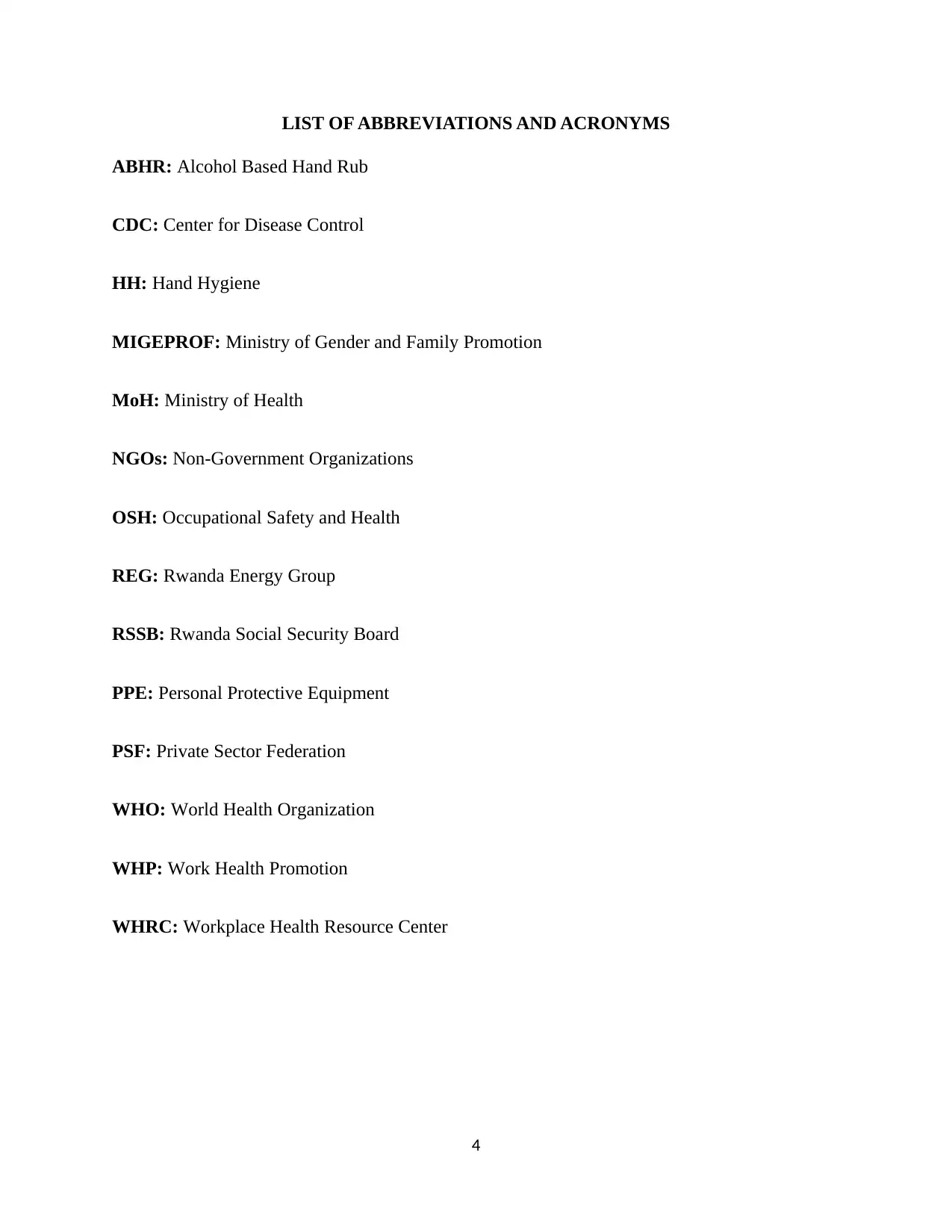
LIST OF ABBREVIATIONS AND ACRONYMS
ABHR: Alcohol Based Hand Rub
CDC: Center for Disease Control
HH: Hand Hygiene
MIGEPROF: Ministry of Gender and Family Promotion
MoH: Ministry of Health
NGOs: Non-Government Organizations
OSH: Occupational Safety and Health
REG: Rwanda Energy Group
RSSB: Rwanda Social Security Board
PPE: Personal Protective Equipment
PSF: Private Sector Federation
WHO: World Health Organization
WHP: Work Health Promotion
WHRC: Workplace Health Resource Center
4
ABHR: Alcohol Based Hand Rub
CDC: Center for Disease Control
HH: Hand Hygiene
MIGEPROF: Ministry of Gender and Family Promotion
MoH: Ministry of Health
NGOs: Non-Government Organizations
OSH: Occupational Safety and Health
REG: Rwanda Energy Group
RSSB: Rwanda Social Security Board
PPE: Personal Protective Equipment
PSF: Private Sector Federation
WHO: World Health Organization
WHP: Work Health Promotion
WHRC: Workplace Health Resource Center
4
Paraphrase This Document
Need a fresh take? Get an instant paraphrase of this document with our AI Paraphraser
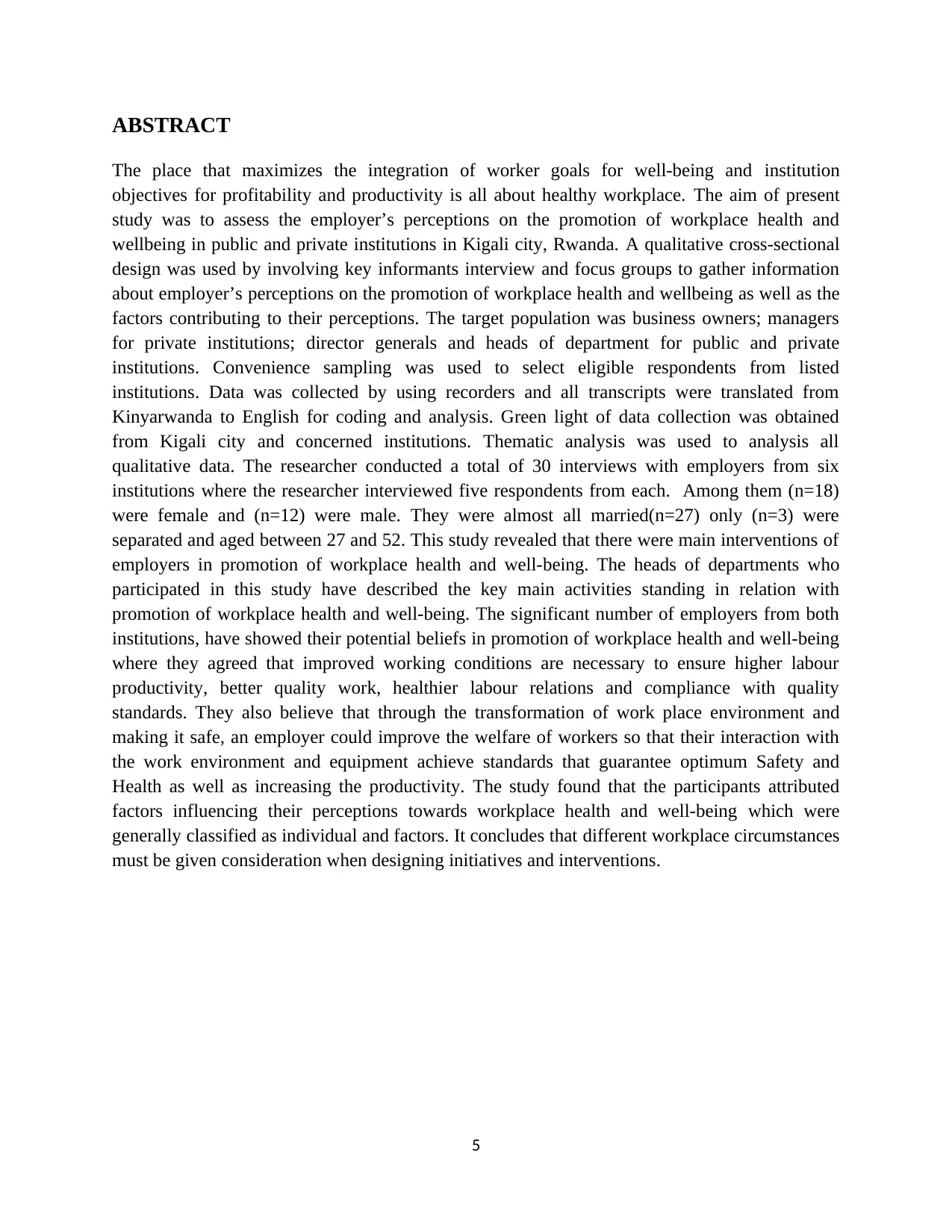
ABSTRACT
The place that maximizes the integration of worker goals for well-being and institution
objectives for profitability and productivity is all about healthy workplace. The aim of present
study was to assess the employer’s perceptions on the promotion of workplace health and
wellbeing in public and private institutions in Kigali city, Rwanda. A qualitative cross-sectional
design was used by involving key informants interview and focus groups to gather information
about employer’s perceptions on the promotion of workplace health and wellbeing as well as the
factors contributing to their perceptions. The target population was business owners; managers
for private institutions; director generals and heads of department for public and private
institutions. Convenience sampling was used to select eligible respondents from listed
institutions. Data was collected by using recorders and all transcripts were translated from
Kinyarwanda to English for coding and analysis. Green light of data collection was obtained
from Kigali city and concerned institutions. Thematic analysis was used to analysis all
qualitative data. The researcher conducted a total of 30 interviews with employers from six
institutions where the researcher interviewed five respondents from each. Among them (n=18)
were female and (n=12) were male. They were almost all married(n=27) only (n=3) were
separated and aged between 27 and 52. This study revealed that there were main interventions of
employers in promotion of workplace health and well-being. The heads of departments who
participated in this study have described the key main activities standing in relation with
promotion of workplace health and well-being. The significant number of employers from both
institutions, have showed their potential beliefs in promotion of workplace health and well-being
where they agreed that improved working conditions are necessary to ensure higher labour
productivity, better quality work, healthier labour relations and compliance with quality
standards. They also believe that through the transformation of work place environment and
making it safe, an employer could improve the welfare of workers so that their interaction with
the work environment and equipment achieve standards that guarantee optimum Safety and
Health as well as increasing the productivity. The study found that the participants attributed
factors influencing their perceptions towards workplace health and well-being which were
generally classified as individual and factors. It concludes that different workplace circumstances
must be given consideration when designing initiatives and interventions.
5
The place that maximizes the integration of worker goals for well-being and institution
objectives for profitability and productivity is all about healthy workplace. The aim of present
study was to assess the employer’s perceptions on the promotion of workplace health and
wellbeing in public and private institutions in Kigali city, Rwanda. A qualitative cross-sectional
design was used by involving key informants interview and focus groups to gather information
about employer’s perceptions on the promotion of workplace health and wellbeing as well as the
factors contributing to their perceptions. The target population was business owners; managers
for private institutions; director generals and heads of department for public and private
institutions. Convenience sampling was used to select eligible respondents from listed
institutions. Data was collected by using recorders and all transcripts were translated from
Kinyarwanda to English for coding and analysis. Green light of data collection was obtained
from Kigali city and concerned institutions. Thematic analysis was used to analysis all
qualitative data. The researcher conducted a total of 30 interviews with employers from six
institutions where the researcher interviewed five respondents from each. Among them (n=18)
were female and (n=12) were male. They were almost all married(n=27) only (n=3) were
separated and aged between 27 and 52. This study revealed that there were main interventions of
employers in promotion of workplace health and well-being. The heads of departments who
participated in this study have described the key main activities standing in relation with
promotion of workplace health and well-being. The significant number of employers from both
institutions, have showed their potential beliefs in promotion of workplace health and well-being
where they agreed that improved working conditions are necessary to ensure higher labour
productivity, better quality work, healthier labour relations and compliance with quality
standards. They also believe that through the transformation of work place environment and
making it safe, an employer could improve the welfare of workers so that their interaction with
the work environment and equipment achieve standards that guarantee optimum Safety and
Health as well as increasing the productivity. The study found that the participants attributed
factors influencing their perceptions towards workplace health and well-being which were
generally classified as individual and factors. It concludes that different workplace circumstances
must be given consideration when designing initiatives and interventions.
5
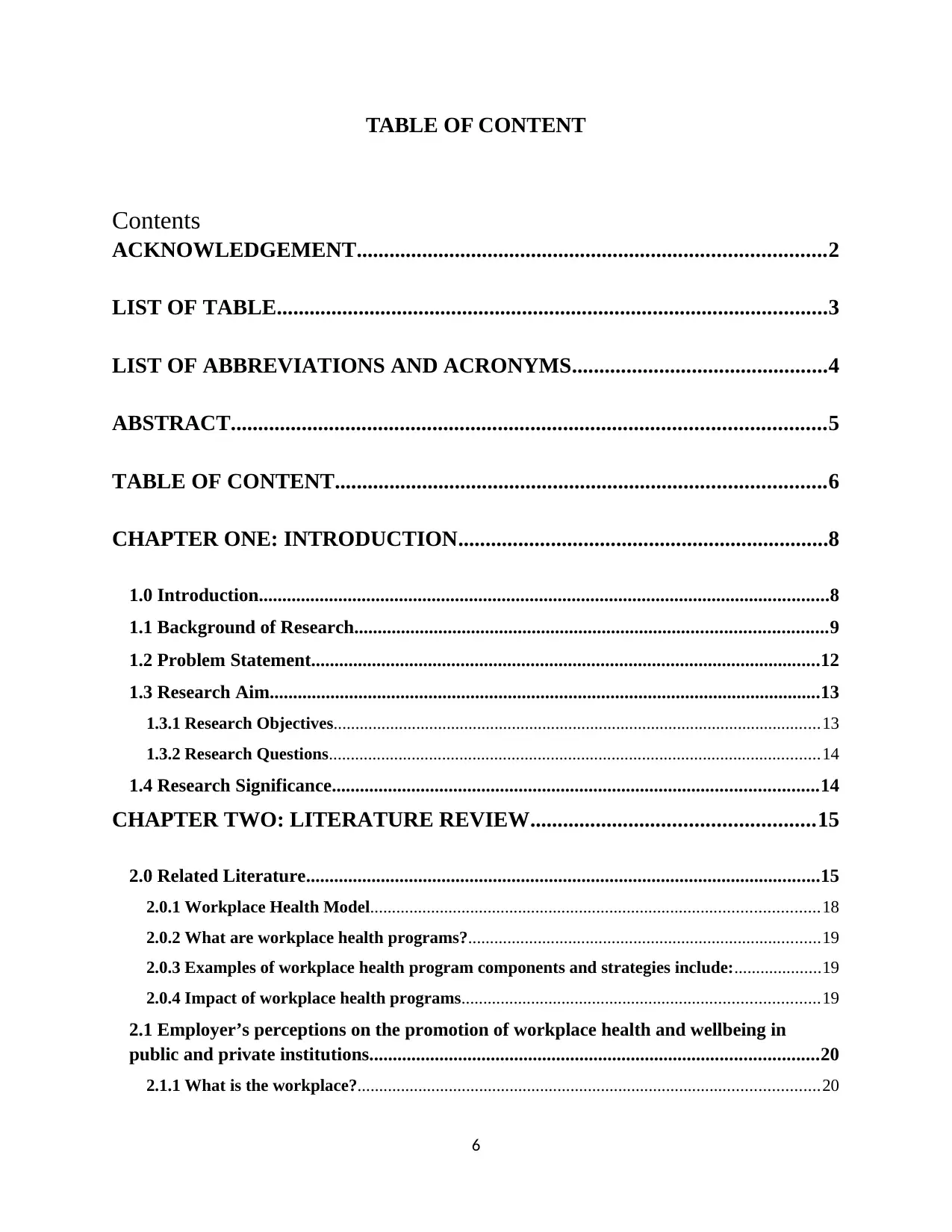
TABLE OF CONTENT
Contents
ACKNOWLEDGEMENT......................................................................................2
LIST OF TABLE.....................................................................................................3
LIST OF ABBREVIATIONS AND ACRONYMS...............................................4
ABSTRACT.............................................................................................................5
TABLE OF CONTENT..........................................................................................6
CHAPTER ONE: INTRODUCTION....................................................................8
1.0 Introduction..........................................................................................................................8
1.1 Background of Research.....................................................................................................9
1.2 Problem Statement.............................................................................................................12
1.3 Research Aim......................................................................................................................13
1.3.1 Research Objectives................................................................................................................13
1.3.2 Research Questions.................................................................................................................14
1.4 Research Significance........................................................................................................14
CHAPTER TWO: LITERATURE REVIEW....................................................15
2.0 Related Literature..............................................................................................................15
2.0.1 Workplace Health Model.......................................................................................................18
2.0.2 What are workplace health programs?.................................................................................19
2.0.3 Examples of workplace health program components and strategies include:....................19
2.0.4 Impact of workplace health programs..................................................................................19
2.1 Employer’s perceptions on the promotion of workplace health and wellbeing in
public and private institutions................................................................................................20
2.1.1 What is the workplace?..........................................................................................................20
6
Contents
ACKNOWLEDGEMENT......................................................................................2
LIST OF TABLE.....................................................................................................3
LIST OF ABBREVIATIONS AND ACRONYMS...............................................4
ABSTRACT.............................................................................................................5
TABLE OF CONTENT..........................................................................................6
CHAPTER ONE: INTRODUCTION....................................................................8
1.0 Introduction..........................................................................................................................8
1.1 Background of Research.....................................................................................................9
1.2 Problem Statement.............................................................................................................12
1.3 Research Aim......................................................................................................................13
1.3.1 Research Objectives................................................................................................................13
1.3.2 Research Questions.................................................................................................................14
1.4 Research Significance........................................................................................................14
CHAPTER TWO: LITERATURE REVIEW....................................................15
2.0 Related Literature..............................................................................................................15
2.0.1 Workplace Health Model.......................................................................................................18
2.0.2 What are workplace health programs?.................................................................................19
2.0.3 Examples of workplace health program components and strategies include:....................19
2.0.4 Impact of workplace health programs..................................................................................19
2.1 Employer’s perceptions on the promotion of workplace health and wellbeing in
public and private institutions................................................................................................20
2.1.1 What is the workplace?..........................................................................................................20
6
⊘ This is a preview!⊘
Do you want full access?
Subscribe today to unlock all pages.

Trusted by 1+ million students worldwide
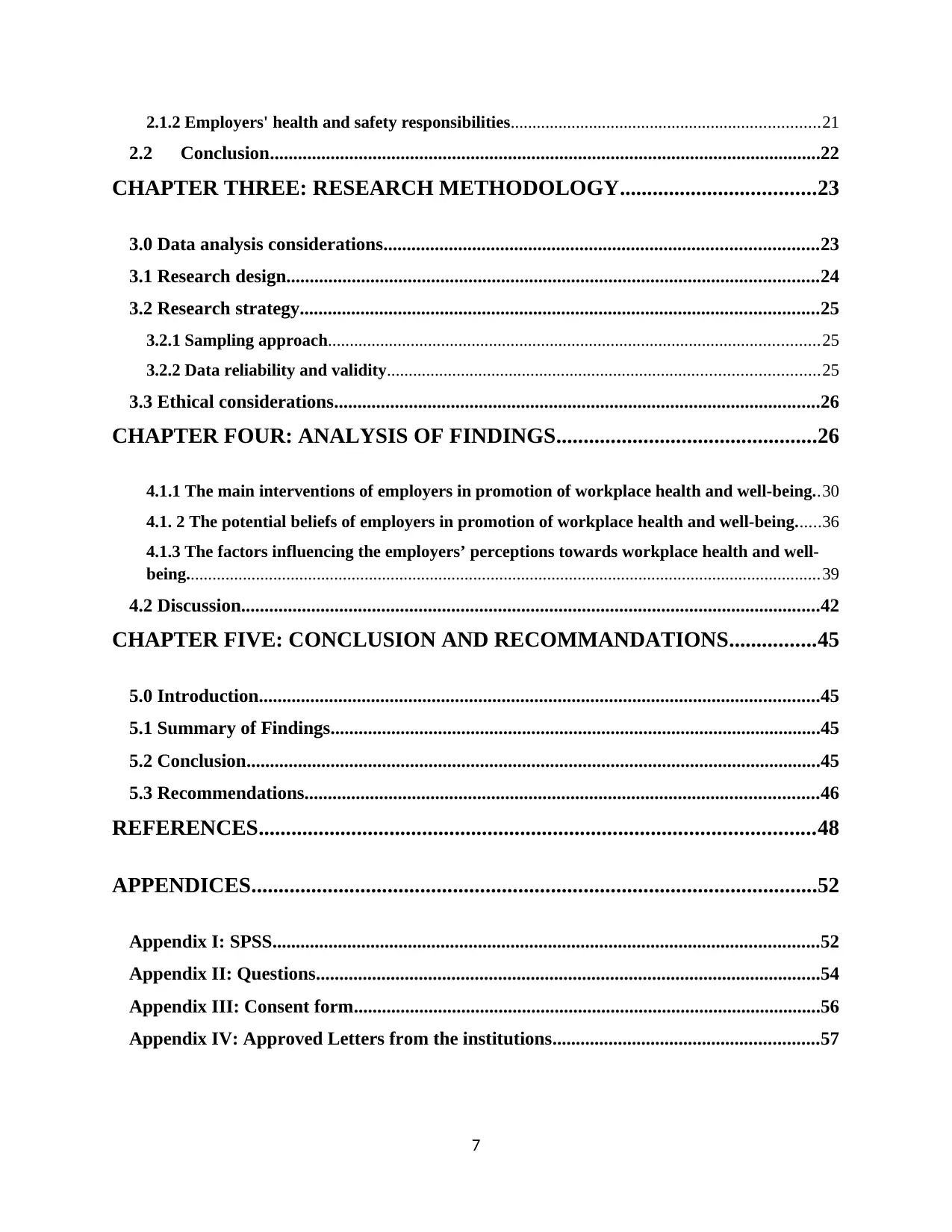
2.1.2 Employers' health and safety responsibilities.......................................................................21
2.2 Conclusion......................................................................................................................22
CHAPTER THREE: RESEARCH METHODOLOGY....................................23
3.0 Data analysis considerations.............................................................................................23
3.1 Research design..................................................................................................................24
3.2 Research strategy...............................................................................................................25
3.2.1 Sampling approach.................................................................................................................25
3.2.2 Data reliability and validity...................................................................................................25
3.3 Ethical considerations........................................................................................................26
CHAPTER FOUR: ANALYSIS OF FINDINGS................................................26
4.1.1 The main interventions of employers in promotion of workplace health and well-being..30
4.1. 2 The potential beliefs of employers in promotion of workplace health and well-being......36
4.1.3 The factors influencing the employers’ perceptions towards workplace health and well-
being..................................................................................................................................................39
4.2 Discussion............................................................................................................................42
CHAPTER FIVE: CONCLUSION AND RECOMMANDATIONS................45
5.0 Introduction........................................................................................................................45
5.1 Summary of Findings.........................................................................................................45
5.2 Conclusion...........................................................................................................................45
5.3 Recommendations..............................................................................................................46
REFERENCES......................................................................................................48
APPENDICES........................................................................................................52
Appendix I: SPSS.....................................................................................................................52
Appendix II: Questions............................................................................................................54
Appendix III: Consent form....................................................................................................56
Appendix IV: Approved Letters from the institutions.........................................................57
7
2.2 Conclusion......................................................................................................................22
CHAPTER THREE: RESEARCH METHODOLOGY....................................23
3.0 Data analysis considerations.............................................................................................23
3.1 Research design..................................................................................................................24
3.2 Research strategy...............................................................................................................25
3.2.1 Sampling approach.................................................................................................................25
3.2.2 Data reliability and validity...................................................................................................25
3.3 Ethical considerations........................................................................................................26
CHAPTER FOUR: ANALYSIS OF FINDINGS................................................26
4.1.1 The main interventions of employers in promotion of workplace health and well-being..30
4.1. 2 The potential beliefs of employers in promotion of workplace health and well-being......36
4.1.3 The factors influencing the employers’ perceptions towards workplace health and well-
being..................................................................................................................................................39
4.2 Discussion............................................................................................................................42
CHAPTER FIVE: CONCLUSION AND RECOMMANDATIONS................45
5.0 Introduction........................................................................................................................45
5.1 Summary of Findings.........................................................................................................45
5.2 Conclusion...........................................................................................................................45
5.3 Recommendations..............................................................................................................46
REFERENCES......................................................................................................48
APPENDICES........................................................................................................52
Appendix I: SPSS.....................................................................................................................52
Appendix II: Questions............................................................................................................54
Appendix III: Consent form....................................................................................................56
Appendix IV: Approved Letters from the institutions.........................................................57
7
Paraphrase This Document
Need a fresh take? Get an instant paraphrase of this document with our AI Paraphraser
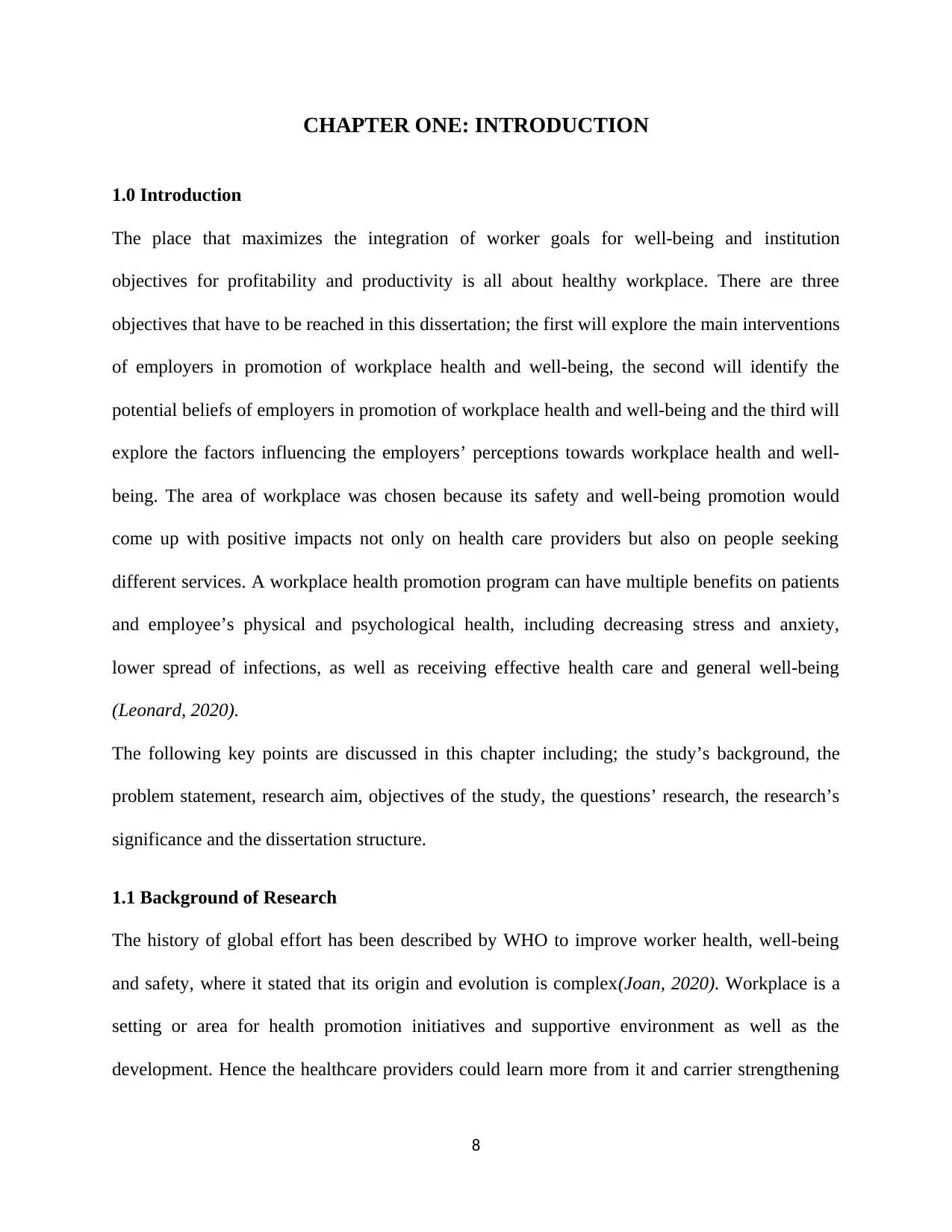
CHAPTER ONE: INTRODUCTION
1.0 Introduction
The place that maximizes the integration of worker goals for well-being and institution
objectives for profitability and productivity is all about healthy workplace. There are three
objectives that have to be reached in this dissertation; the first will explore the main interventions
of employers in promotion of workplace health and well-being, the second will identify the
potential beliefs of employers in promotion of workplace health and well-being and the third will
explore the factors influencing the employers’ perceptions towards workplace health and well-
being. The area of workplace was chosen because its safety and well-being promotion would
come up with positive impacts not only on health care providers but also on people seeking
different services. A workplace health promotion program can have multiple benefits on patients
and employee’s physical and psychological health, including decreasing stress and anxiety,
lower spread of infections, as well as receiving effective health care and general well-being
(Leonard, 2020).
The following key points are discussed in this chapter including; the study’s background, the
problem statement, research aim, objectives of the study, the questions’ research, the research’s
significance and the dissertation structure.
1.1 Background of Research
The history of global effort has been described by WHO to improve worker health, well-being
and safety, where it stated that its origin and evolution is complex(Joan, 2020). Workplace is a
setting or area for health promotion initiatives and supportive environment as well as the
development. Hence the healthcare providers could learn more from it and carrier strengthening
8
1.0 Introduction
The place that maximizes the integration of worker goals for well-being and institution
objectives for profitability and productivity is all about healthy workplace. There are three
objectives that have to be reached in this dissertation; the first will explore the main interventions
of employers in promotion of workplace health and well-being, the second will identify the
potential beliefs of employers in promotion of workplace health and well-being and the third will
explore the factors influencing the employers’ perceptions towards workplace health and well-
being. The area of workplace was chosen because its safety and well-being promotion would
come up with positive impacts not only on health care providers but also on people seeking
different services. A workplace health promotion program can have multiple benefits on patients
and employee’s physical and psychological health, including decreasing stress and anxiety,
lower spread of infections, as well as receiving effective health care and general well-being
(Leonard, 2020).
The following key points are discussed in this chapter including; the study’s background, the
problem statement, research aim, objectives of the study, the questions’ research, the research’s
significance and the dissertation structure.
1.1 Background of Research
The history of global effort has been described by WHO to improve worker health, well-being
and safety, where it stated that its origin and evolution is complex(Joan, 2020). Workplace is a
setting or area for health promotion initiatives and supportive environment as well as the
development. Hence the healthcare providers could learn more from it and carrier strengthening
8
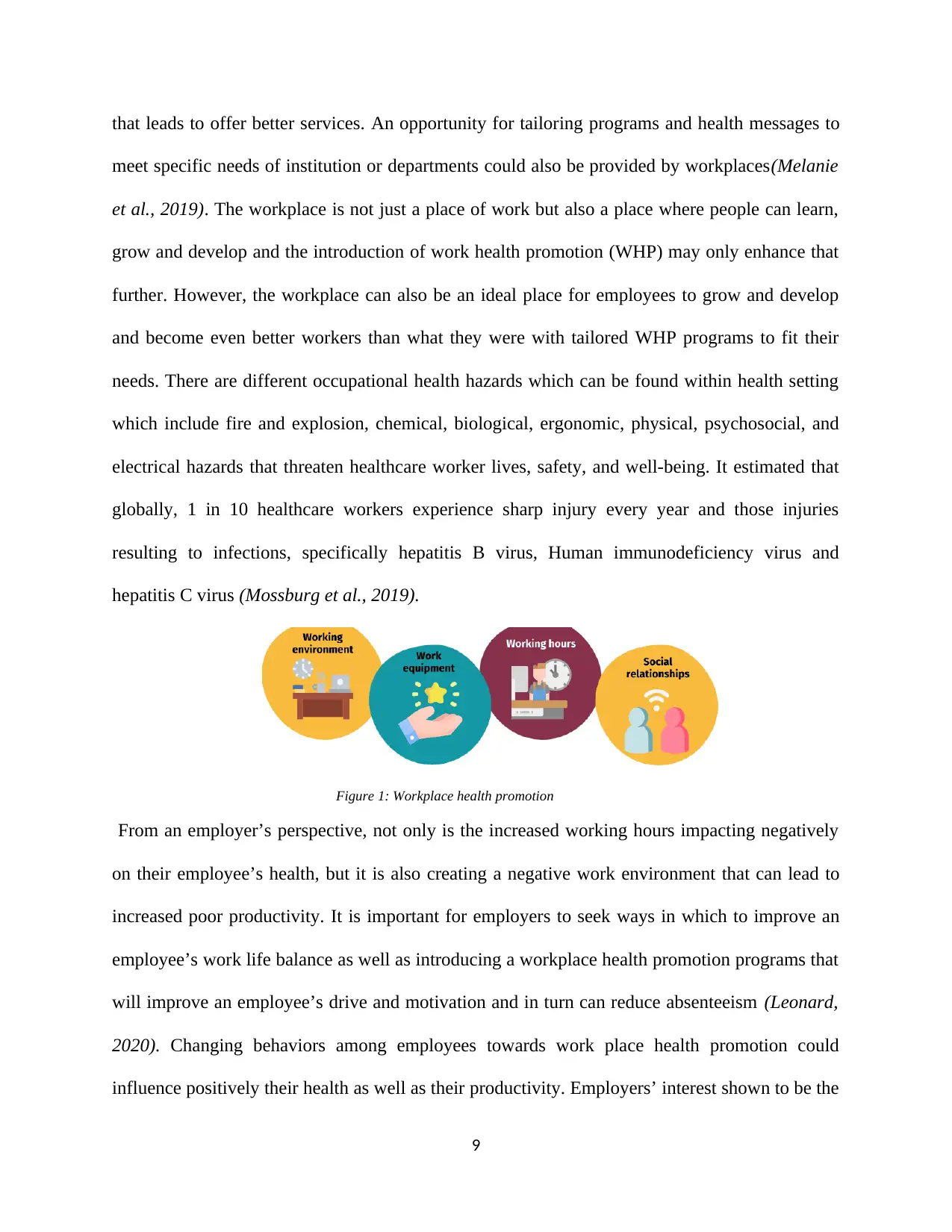
that leads to offer better services. An opportunity for tailoring programs and health messages to
meet specific needs of institution or departments could also be provided by workplaces(Melanie
et al., 2019). The workplace is not just a place of work but also a place where people can learn,
grow and develop and the introduction of work health promotion (WHP) may only enhance that
further. However, the workplace can also be an ideal place for employees to grow and develop
and become even better workers than what they were with tailored WHP programs to fit their
needs. There are different occupational health hazards which can be found within health setting
which include fire and explosion, chemical, biological, ergonomic, physical, psychosocial, and
electrical hazards that threaten healthcare worker lives, safety, and well-being. It estimated that
globally, 1 in 10 healthcare workers experience sharp injury every year and those injuries
resulting to infections, specifically hepatitis B virus, Human immunodeficiency virus and
hepatitis C virus (Mossburg et al., 2019).
Figure 1: Workplace health promotion
From an employer’s perspective, not only is the increased working hours impacting negatively
on their employee’s health, but it is also creating a negative work environment that can lead to
increased poor productivity. It is important for employers to seek ways in which to improve an
employee’s work life balance as well as introducing a workplace health promotion programs that
will improve an employee’s drive and motivation and in turn can reduce absenteeism (Leonard,
2020). Changing behaviors among employees towards work place health promotion could
influence positively their health as well as their productivity. Employers’ interest shown to be the
9
meet specific needs of institution or departments could also be provided by workplaces(Melanie
et al., 2019). The workplace is not just a place of work but also a place where people can learn,
grow and develop and the introduction of work health promotion (WHP) may only enhance that
further. However, the workplace can also be an ideal place for employees to grow and develop
and become even better workers than what they were with tailored WHP programs to fit their
needs. There are different occupational health hazards which can be found within health setting
which include fire and explosion, chemical, biological, ergonomic, physical, psychosocial, and
electrical hazards that threaten healthcare worker lives, safety, and well-being. It estimated that
globally, 1 in 10 healthcare workers experience sharp injury every year and those injuries
resulting to infections, specifically hepatitis B virus, Human immunodeficiency virus and
hepatitis C virus (Mossburg et al., 2019).
Figure 1: Workplace health promotion
From an employer’s perspective, not only is the increased working hours impacting negatively
on their employee’s health, but it is also creating a negative work environment that can lead to
increased poor productivity. It is important for employers to seek ways in which to improve an
employee’s work life balance as well as introducing a workplace health promotion programs that
will improve an employee’s drive and motivation and in turn can reduce absenteeism (Leonard,
2020). Changing behaviors among employees towards work place health promotion could
influence positively their health as well as their productivity. Employers’ interest shown to be the
9
⊘ This is a preview!⊘
Do you want full access?
Subscribe today to unlock all pages.

Trusted by 1+ million students worldwide
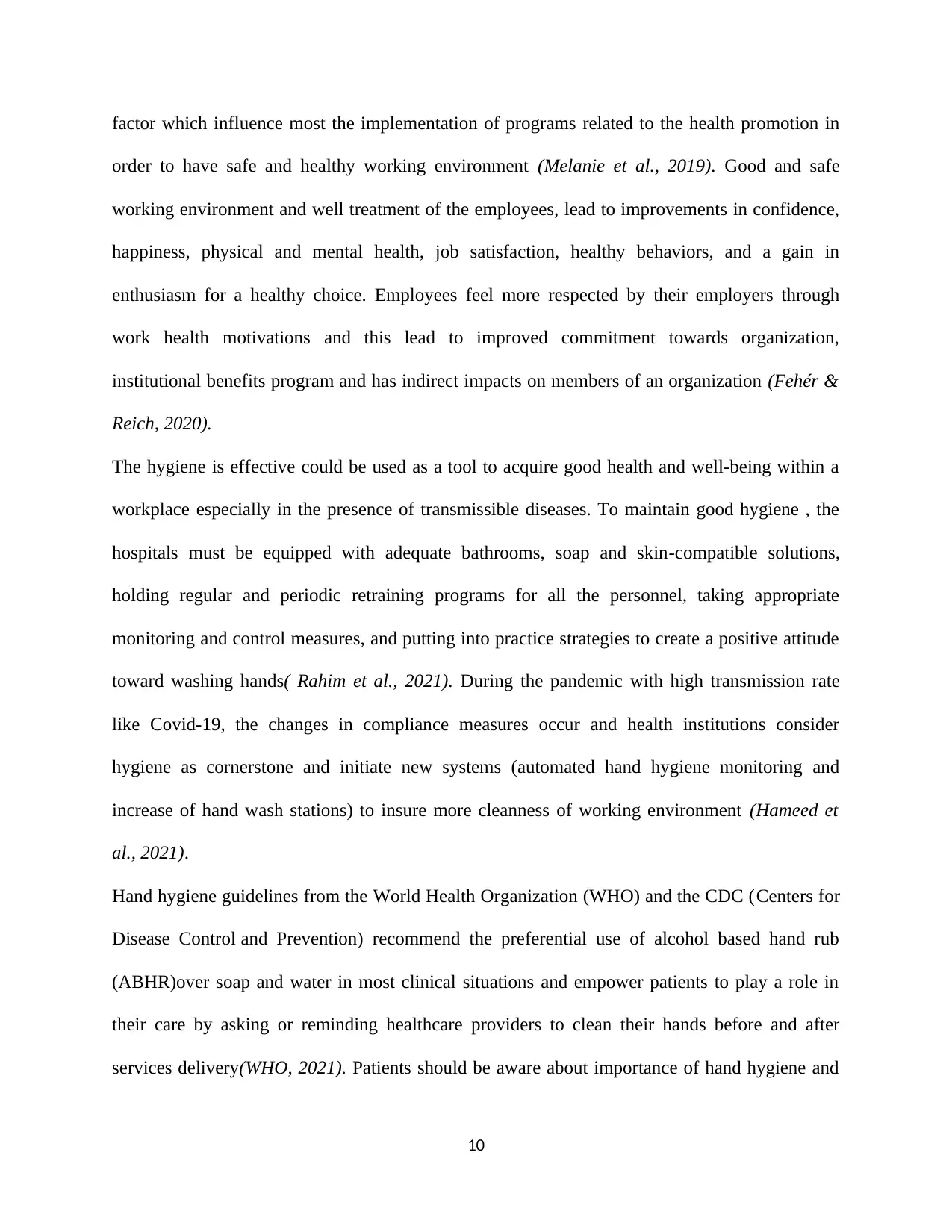
factor which influence most the implementation of programs related to the health promotion in
order to have safe and healthy working environment (Melanie et al., 2019). Good and safe
working environment and well treatment of the employees, lead to improvements in confidence,
happiness, physical and mental health, job satisfaction, healthy behaviors, and a gain in
enthusiasm for a healthy choice. Employees feel more respected by their employers through
work health motivations and this lead to improved commitment towards organization,
institutional benefits program and has indirect impacts on members of an organization (Fehér &
Reich, 2020).
The hygiene is effective could be used as a tool to acquire good health and well-being within a
workplace especially in the presence of transmissible diseases. To maintain good hygiene , the
hospitals must be equipped with adequate bathrooms, soap and skin-compatible solutions,
holding regular and periodic retraining programs for all the personnel, taking appropriate
monitoring and control measures, and putting into practice strategies to create a positive attitude
toward washing hands( Rahim et al., 2021). During the pandemic with high transmission rate
like Covid-19, the changes in compliance measures occur and health institutions consider
hygiene as cornerstone and initiate new systems (automated hand hygiene monitoring and
increase of hand wash stations) to insure more cleanness of working environment (Hameed et
al., 2021).
Hand hygiene guidelines from the World Health Organization (WHO) and the CDC (Centers for
Disease Control and Prevention) recommend the preferential use of alcohol based hand rub
(ABHR)over soap and water in most clinical situations and empower patients to play a role in
their care by asking or reminding healthcare providers to clean their hands before and after
services delivery(WHO, 2021). Patients should be aware about importance of hand hygiene and
10
order to have safe and healthy working environment (Melanie et al., 2019). Good and safe
working environment and well treatment of the employees, lead to improvements in confidence,
happiness, physical and mental health, job satisfaction, healthy behaviors, and a gain in
enthusiasm for a healthy choice. Employees feel more respected by their employers through
work health motivations and this lead to improved commitment towards organization,
institutional benefits program and has indirect impacts on members of an organization (Fehér &
Reich, 2020).
The hygiene is effective could be used as a tool to acquire good health and well-being within a
workplace especially in the presence of transmissible diseases. To maintain good hygiene , the
hospitals must be equipped with adequate bathrooms, soap and skin-compatible solutions,
holding regular and periodic retraining programs for all the personnel, taking appropriate
monitoring and control measures, and putting into practice strategies to create a positive attitude
toward washing hands( Rahim et al., 2021). During the pandemic with high transmission rate
like Covid-19, the changes in compliance measures occur and health institutions consider
hygiene as cornerstone and initiate new systems (automated hand hygiene monitoring and
increase of hand wash stations) to insure more cleanness of working environment (Hameed et
al., 2021).
Hand hygiene guidelines from the World Health Organization (WHO) and the CDC (Centers for
Disease Control and Prevention) recommend the preferential use of alcohol based hand rub
(ABHR)over soap and water in most clinical situations and empower patients to play a role in
their care by asking or reminding healthcare providers to clean their hands before and after
services delivery(WHO, 2021). Patients should be aware about importance of hand hygiene and
10
Paraphrase This Document
Need a fresh take? Get an instant paraphrase of this document with our AI Paraphraser
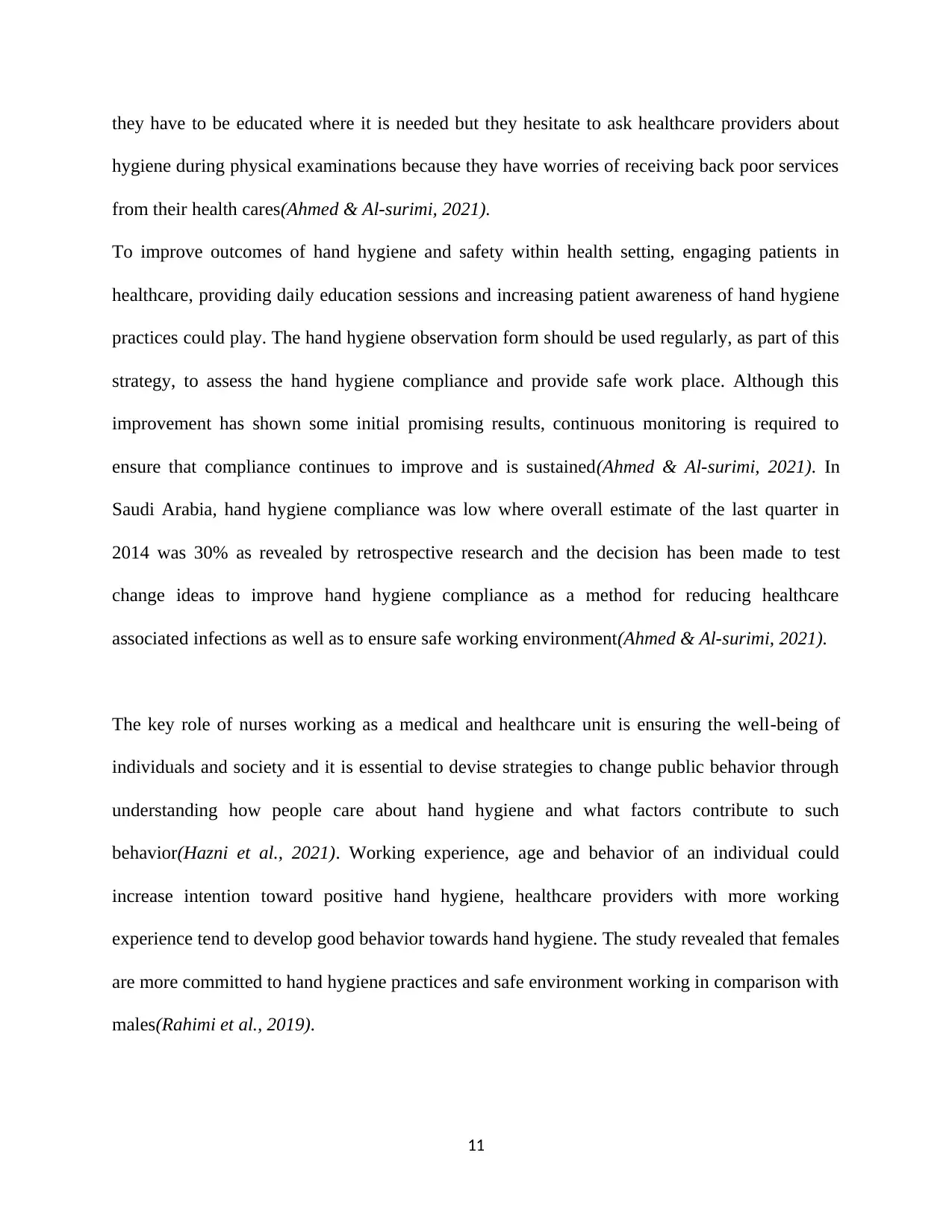
they have to be educated where it is needed but they hesitate to ask healthcare providers about
hygiene during physical examinations because they have worries of receiving back poor services
from their health cares(Ahmed & Al-surimi, 2021).
To improve outcomes of hand hygiene and safety within health setting, engaging patients in
healthcare, providing daily education sessions and increasing patient awareness of hand hygiene
practices could play. The hand hygiene observation form should be used regularly, as part of this
strategy, to assess the hand hygiene compliance and provide safe work place. Although this
improvement has shown some initial promising results, continuous monitoring is required to
ensure that compliance continues to improve and is sustained(Ahmed & Al-surimi, 2021). In
Saudi Arabia, hand hygiene compliance was low where overall estimate of the last quarter in
2014 was 30% as revealed by retrospective research and the decision has been made to test
change ideas to improve hand hygiene compliance as a method for reducing healthcare
associated infections as well as to ensure safe working environment(Ahmed & Al-surimi, 2021).
The key role of nurses working as a medical and healthcare unit is ensuring the well-being of
individuals and society and it is essential to devise strategies to change public behavior through
understanding how people care about hand hygiene and what factors contribute to such
behavior(Hazni et al., 2021). Working experience, age and behavior of an individual could
increase intention toward positive hand hygiene, healthcare providers with more working
experience tend to develop good behavior towards hand hygiene. The study revealed that females
are more committed to hand hygiene practices and safe environment working in comparison with
males(Rahimi et al., 2019).
11
hygiene during physical examinations because they have worries of receiving back poor services
from their health cares(Ahmed & Al-surimi, 2021).
To improve outcomes of hand hygiene and safety within health setting, engaging patients in
healthcare, providing daily education sessions and increasing patient awareness of hand hygiene
practices could play. The hand hygiene observation form should be used regularly, as part of this
strategy, to assess the hand hygiene compliance and provide safe work place. Although this
improvement has shown some initial promising results, continuous monitoring is required to
ensure that compliance continues to improve and is sustained(Ahmed & Al-surimi, 2021). In
Saudi Arabia, hand hygiene compliance was low where overall estimate of the last quarter in
2014 was 30% as revealed by retrospective research and the decision has been made to test
change ideas to improve hand hygiene compliance as a method for reducing healthcare
associated infections as well as to ensure safe working environment(Ahmed & Al-surimi, 2021).
The key role of nurses working as a medical and healthcare unit is ensuring the well-being of
individuals and society and it is essential to devise strategies to change public behavior through
understanding how people care about hand hygiene and what factors contribute to such
behavior(Hazni et al., 2021). Working experience, age and behavior of an individual could
increase intention toward positive hand hygiene, healthcare providers with more working
experience tend to develop good behavior towards hand hygiene. The study revealed that females
are more committed to hand hygiene practices and safe environment working in comparison with
males(Rahimi et al., 2019).
11
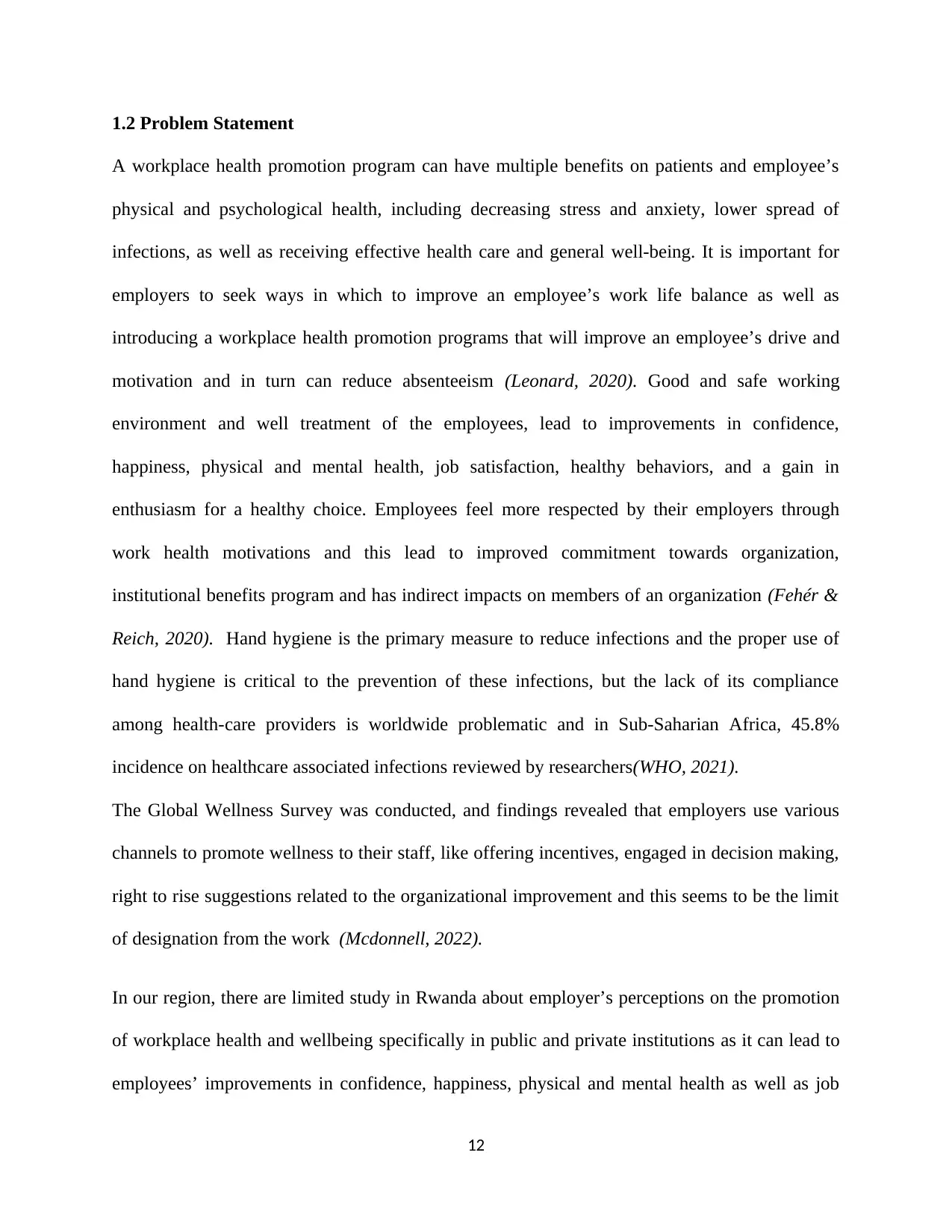
1.2 Problem Statement
A workplace health promotion program can have multiple benefits on patients and employee’s
physical and psychological health, including decreasing stress and anxiety, lower spread of
infections, as well as receiving effective health care and general well-being. It is important for
employers to seek ways in which to improve an employee’s work life balance as well as
introducing a workplace health promotion programs that will improve an employee’s drive and
motivation and in turn can reduce absenteeism (Leonard, 2020). Good and safe working
environment and well treatment of the employees, lead to improvements in confidence,
happiness, physical and mental health, job satisfaction, healthy behaviors, and a gain in
enthusiasm for a healthy choice. Employees feel more respected by their employers through
work health motivations and this lead to improved commitment towards organization,
institutional benefits program and has indirect impacts on members of an organization (Fehér &
Reich, 2020). Hand hygiene is the primary measure to reduce infections and the proper use of
hand hygiene is critical to the prevention of these infections, but the lack of its compliance
among health-care providers is worldwide problematic and in Sub-Saharian Africa, 45.8%
incidence on healthcare associated infections reviewed by researchers(WHO, 2021).
The Global Wellness Survey was conducted, and findings revealed that employers use various
channels to promote wellness to their staff, like offering incentives, engaged in decision making,
right to rise suggestions related to the organizational improvement and this seems to be the limit
of designation from the work (Mcdonnell, 2022).
In our region, there are limited study in Rwanda about employer’s perceptions on the promotion
of workplace health and wellbeing specifically in public and private institutions as it can lead to
employees’ improvements in confidence, happiness, physical and mental health as well as job
12
A workplace health promotion program can have multiple benefits on patients and employee’s
physical and psychological health, including decreasing stress and anxiety, lower spread of
infections, as well as receiving effective health care and general well-being. It is important for
employers to seek ways in which to improve an employee’s work life balance as well as
introducing a workplace health promotion programs that will improve an employee’s drive and
motivation and in turn can reduce absenteeism (Leonard, 2020). Good and safe working
environment and well treatment of the employees, lead to improvements in confidence,
happiness, physical and mental health, job satisfaction, healthy behaviors, and a gain in
enthusiasm for a healthy choice. Employees feel more respected by their employers through
work health motivations and this lead to improved commitment towards organization,
institutional benefits program and has indirect impacts on members of an organization (Fehér &
Reich, 2020). Hand hygiene is the primary measure to reduce infections and the proper use of
hand hygiene is critical to the prevention of these infections, but the lack of its compliance
among health-care providers is worldwide problematic and in Sub-Saharian Africa, 45.8%
incidence on healthcare associated infections reviewed by researchers(WHO, 2021).
The Global Wellness Survey was conducted, and findings revealed that employers use various
channels to promote wellness to their staff, like offering incentives, engaged in decision making,
right to rise suggestions related to the organizational improvement and this seems to be the limit
of designation from the work (Mcdonnell, 2022).
In our region, there are limited study in Rwanda about employer’s perceptions on the promotion
of workplace health and wellbeing specifically in public and private institutions as it can lead to
employees’ improvements in confidence, happiness, physical and mental health as well as job
12
⊘ This is a preview!⊘
Do you want full access?
Subscribe today to unlock all pages.

Trusted by 1+ million students worldwide
1 out of 59
Your All-in-One AI-Powered Toolkit for Academic Success.
+13062052269
info@desklib.com
Available 24*7 on WhatsApp / Email
![[object Object]](/_next/static/media/star-bottom.7253800d.svg)
Unlock your academic potential
Copyright © 2020–2025 A2Z Services. All Rights Reserved. Developed and managed by ZUCOL.

